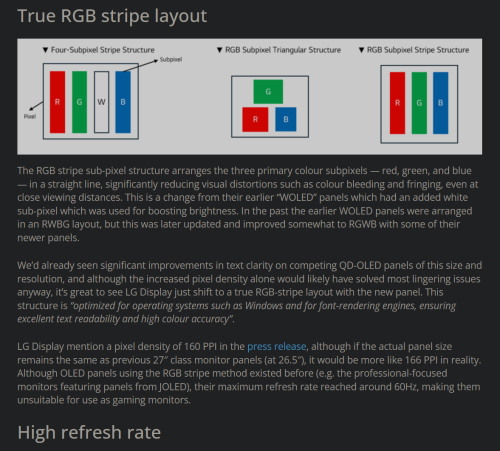RGB stripe Tandem OLED "coming out" next year.
So LG now going to simultaneously fight both Samsung and TCL CSOT with their new LG 27 inch 4K RGB Tandem OLED.
LCD Monitor Thread v13.
|
|
 Dec 23 2025, 02:09 PM Dec 23 2025, 02:09 PM
|

Junior Member
21 posts Joined: Dec 2004 |
Now LG got 2 kinds of OLED.... Tandem WOLED and Tandem OLED.
RGB stripe Tandem OLED "coming out" next year. So LG now going to simultaneously fight both Samsung and TCL CSOT with their new LG 27 inch 4K RGB Tandem OLED. |
|
|
|
|
|
 Dec 23 2025, 05:22 PM Dec 23 2025, 05:22 PM
|
     
Senior Member
1,596 posts Joined: Mar 2014 From: 75°26'11.6"S, 136°16'16.0"E |
https://tftcentral.co.uk/news/lg-display-an...b-stripe-layout
 RGB stripe tandem OLED, 27" 4K release 32" 4K and we game |
|
|
 Yesterday, 08:19 AM Yesterday, 08:19 AM
Show posts by this member only | IPv6 | Post
#3443
|
 
Junior Member
76 posts Joined: Oct 2021 |
Hi, can anyone suggest me an affordable Type C monitor with minimum 24 inch FHD 75hz ? Thanks!
|
|
|
 Yesterday, 09:46 PM Yesterday, 09:46 PM
|
     
Senior Member
1,399 posts Joined: Feb 2012 From: sOuL SoCiETY.. iSKaNDaRPuTeRi.. JB.. JDT |
seem my Dell U2720QM start showing several line of dead pixels thing any recommended similar replacement? |
| Change to: |  0.0128sec 0.0128sec
 0.35 0.35
 6 queries 6 queries
 GZIP Disabled GZIP Disabled
Time is now: 25th December 2025 - 02:35 AM |